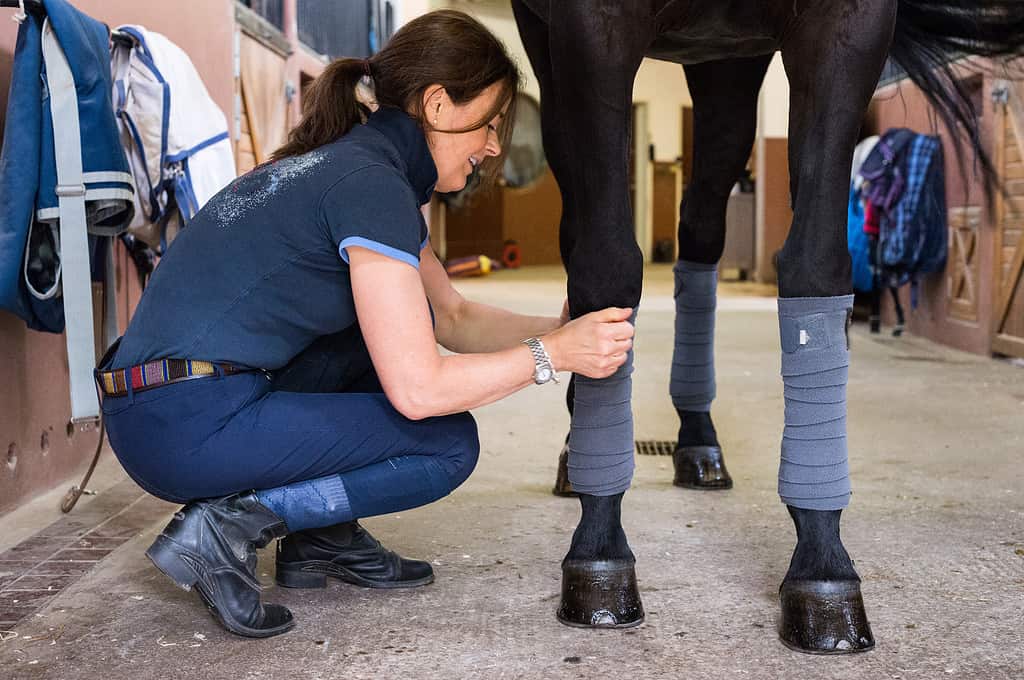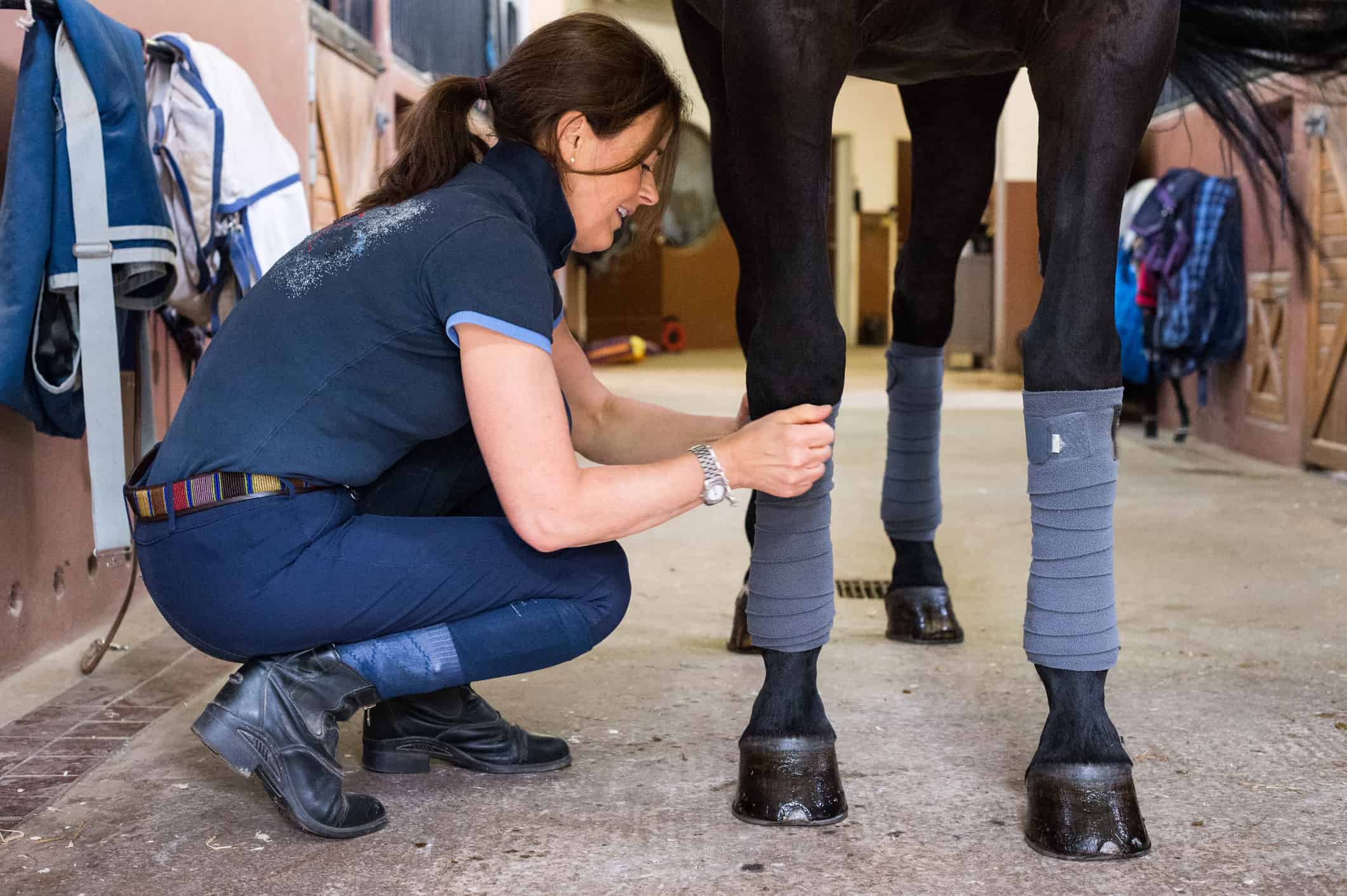If you own horses, you know there are a million and one things to keep in mind if you want to keep them alive. As flighty prey animals with a digestive and skeletal system set up for failure, it’s important to prioritize prevention and be prepared for when something bad inevitably happens. Knowing the ins and outs of wrapping horse legs is part of a solid foundation for equine ownership. Especially given their spindly stems! Let’s learn all about leg wraps, why they matter, and how to properly use them on your horse.
Types of Leg Wraps for Horses

You can wrap your horse’s legs to protect it during a ride, trailering, or from further injury.
©Wirestock/iStock via Getty Images
There are a few different kinds of wraps to use depending on the situation. Those include:
| Type | Material | Purpose |
|---|---|---|
| Standing wraps | A cotton or quilt pad under an elastic bandage | Used when your horse is injured to keep swelling down |
| Vet wraps | An elastic bandage | Used to keep pads or medications in place |
| Polo/exercise wraps | A fleece wrap | Used to protect tendons, bones, and ligaments during intense exercise |
| Ice boots | A protective boot | Used when your horse is injured to keep swelling down |
| Splint/brush boots | Neoprene foam inside a protective outer shell | Used to protect bones and tendons from damage during a ride or travel |
Each performs a different function, so the type you choose depends on how you plan to use it. With that in mind, let’s get more into why you would need to wrap your horse’s legs in the first place!
What Are Horse Leg Wraps For?

You might use a leg wrap to bandage an injury.
©Blanscape/Shutterstock.com
Leg wraps are bandages or boots that you use on a horse to either prevent an injury from happening or to help heal an injury that has already occurred.
Why Wrap Horses’ Legs?
The goal of wrapping horses’ legs is to protect their cannon bones, tendons, fetlocks, pasterns, coronets, and heels from damage. If they already got hurt, you wrap their legs to protect them from further damage or to seal the wound so it heals.
It’s important to know this foundational skill as an equestrian because horses don’t have muscle below their hocks (on the back legs) or knees (on the front legs). That makes these areas vulnerable to trauma such as strain on their tendons, soreness from swelling, or external injuries like a cut or puncture.
However, it’s also crucial to know each type of leg wrap’s unique purpose. For example, a standing wrap is used for physical injuries, open wounds, or when a horse is stocking up.
Stocking up happens when they don’t move around a lot. You might see this in horses that are in a stall or trailer a lot.
According to Alisha Jackson, owner and barn manager of Blue Mountain Pet Care in Virginia, “Horses are designed to walk all day long. Movement contracts and retracts their muscles, stimulating their lymphatic system. When movement stops, less circulation happens and swelling can occur. This can cause edema or a build-up of fluid in their legs.”
This is when knowing how to wrap a horse’s leg comes in handy.
How to Wrap a Horse’s Leg: Your Step-by-Step Guide

There is a right and a wrong way to put on polo wraps.
©LottaVess/iStock via Getty Images
Lucky for you, here’s a simple 5-step guide on how to wrap a horse’s leg with a polo wrap. Just be sure to consult your vet beforehand as improper wrapping can cause serious damage.
1. Clean the Area
Wipe off any dirt and debris on their leg with a brush. If you bathe your horse, give them time to dry.
2. Start Wrapping
Grab your fleece band and begin wrapping from the front of their leg, pulling to the back. Start on the inside of the cannon bone above the fetlock joint.
3. Check Your Work
Before you do a full wrap, ensure you’ve applied even pressure, don’t have wrinkles, and that everything is lined up perfectly. Not wrapping your horse’s legs properly can lead to serious problems like bowed tendons.
4. Continue wrapping
Once the wrap is aligned, continue to wrap up and down the correct part of your horse’s leg. Do this in a spiral pattern until the wrap is evenly distributed. Once you’re satisfied with the coverage, rip off the excess wrap and either stick it to itself or tuck it in.
5. Double-Check Your Work
You’re not done just yet! This is your chance to double-check that you’ve wrapped it evenly around their leg and that it has the right amount of tension. You’ll know it’s too tight if you can’t stick your fingers under the wrap. The idea is to apply pressure, not cut off circulation.
Bonus Step
If you’re doing a standing wrap versus a polo wrap, it adds an extra step. In this case, Step 2 is to apply a cotton or quilt pad. That’s your base layer. Start by folding the pad, placing it at the inside of the cannon bone above the fetlock joint, and wrapping front to back. Continue with the steps as normal by putting the vet wrap over the pad. Just be sure to leave 1/2 an inch of the pad sticking out the top and bottom of the wrap.
As always, consult your veterinarian first. They have the knowledge and experience to expertly wrap your horse’s legs (and show you how to do it too).
FAQs

Wrapping your horse’s injured leg keeps their wounds free of debris.
©Jacob Wackerhausen/iStock via Getty Images
Should I Wrap My Horse’s Legs For a Long Trip?
Whether you use leg wraps for a trip depends on a few factors. If you know how to properly wrap horse legs and can change them often, then you should. Horses are prone to injury during transport, so it’s not a bad idea to put boots or wraps on to protect their legs.
However, improperly wrapping horses’ legs can cause serious — temporary and permanent — damage. Consult your vet before you travel.
How Long Can You Leave a Horse’s Leg Wrapped?
The length of time depends on the type of wrap you’re doing.
Don’t leave ice boots on for more than 30 minutes. Polo wraps and brush/splint boots are for short-term use, so remove them after your ride or when you arrive at your destination. Standing wraps that you’re using for an injury, require that you redress the wounds it’s protecting every few hours hours… at least. Standing wraps for stocking up need to be taken off every 12 hours (sometimes less) to let blood circulation try to flow on its own before redressing.
Where Do You Start When Wrapping a Horse Leg?
When you wrap a horse’s leg, start from the front of their leg and pull to the back. The wrap should start at the inside of the cannon bone above the fetlock joint.
It’s incredibly important that you apply even pressure, ensure there are no wrinkles, and line up the wrap perfectly. Wrapping their legs incorrectly can lead to serious problems like bowed tendons.
What Color Do Horse Leg Wraps Come in?
Polo wraps and boots come in every color and pattern you can imagine. More equestrian brands pop up every day, selling fashionable yet functional products made for horse lovers by horse lovers.
Thank you for reading! Have some feedback for us? Contact the AZ Animals editorial team.








